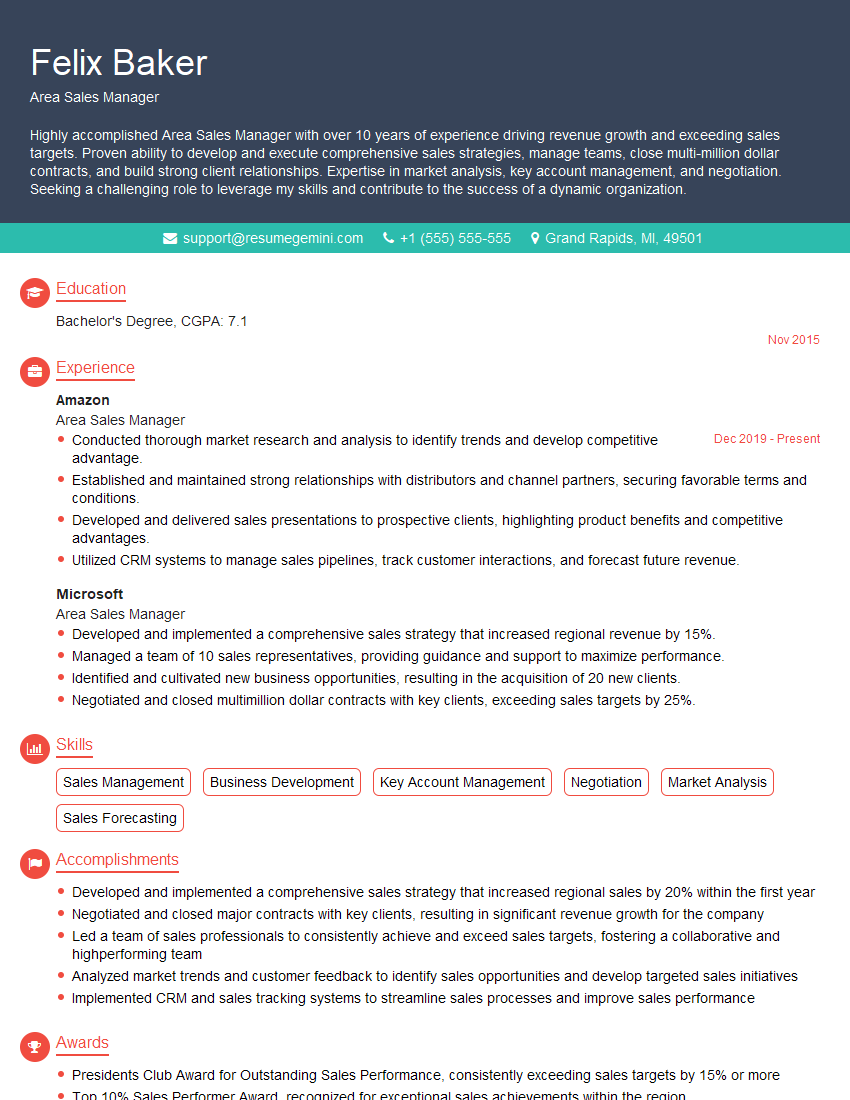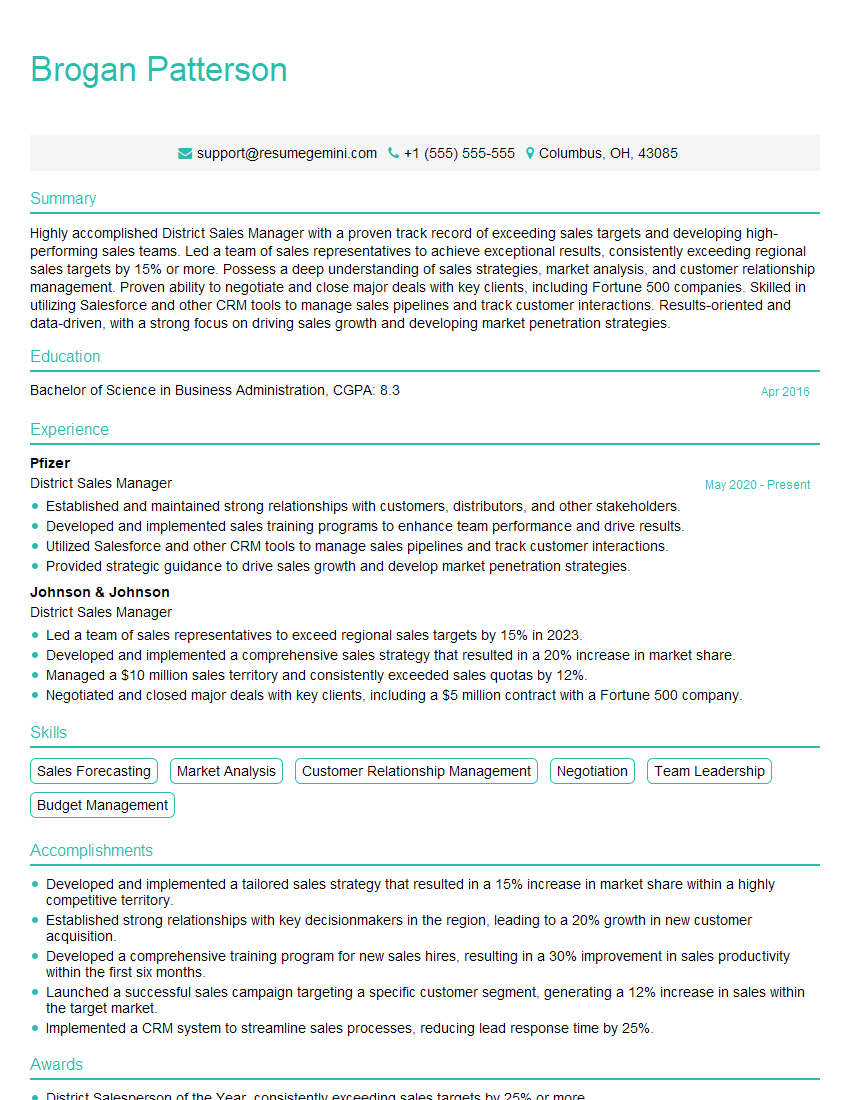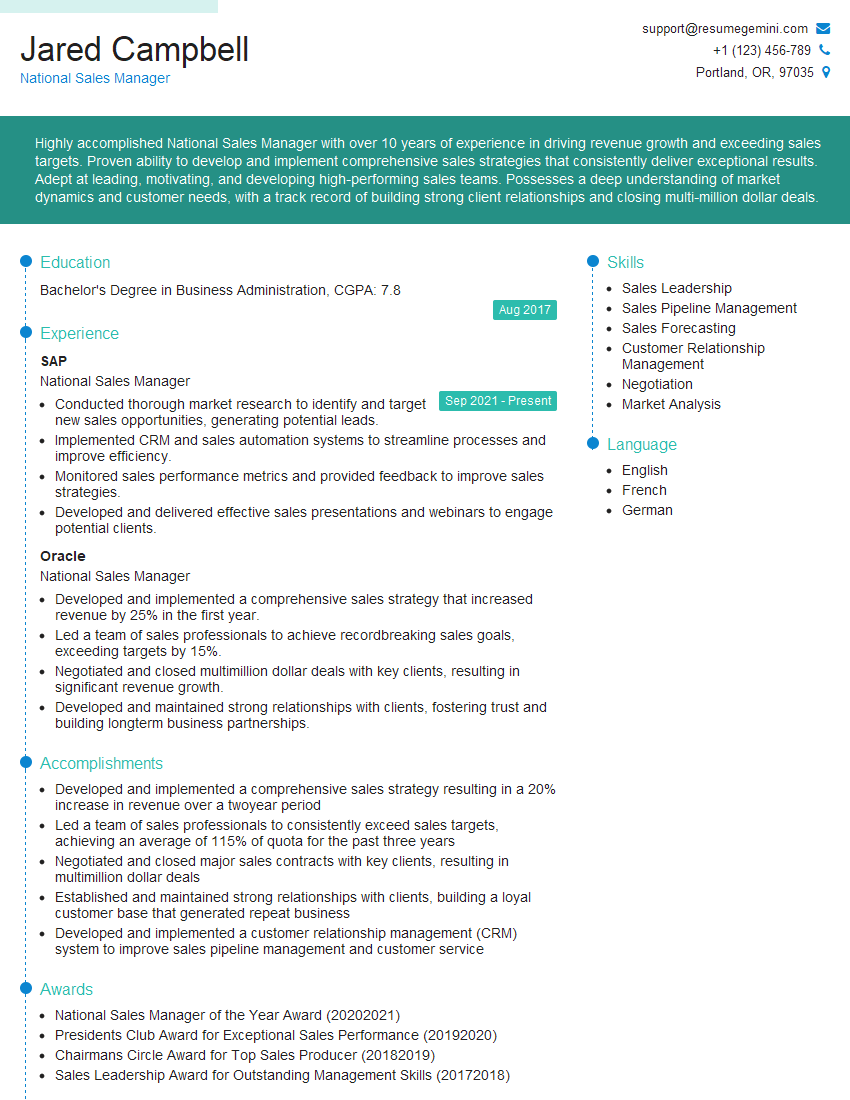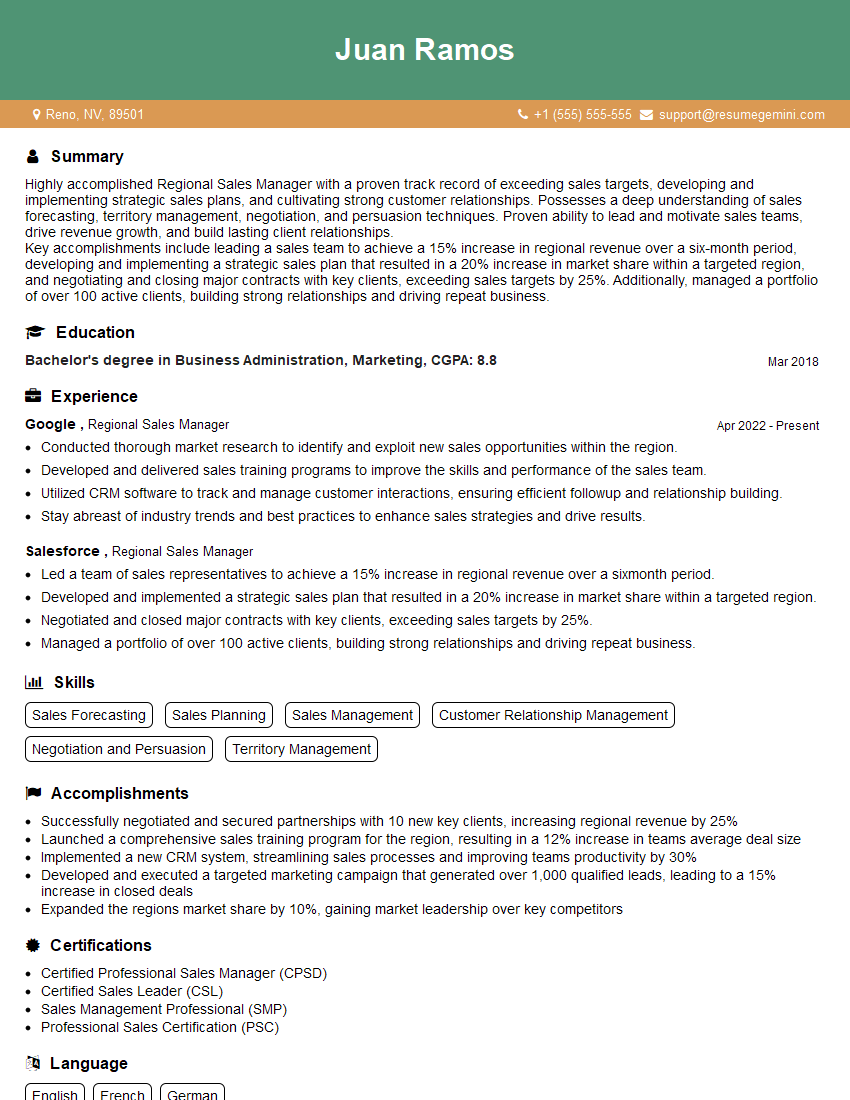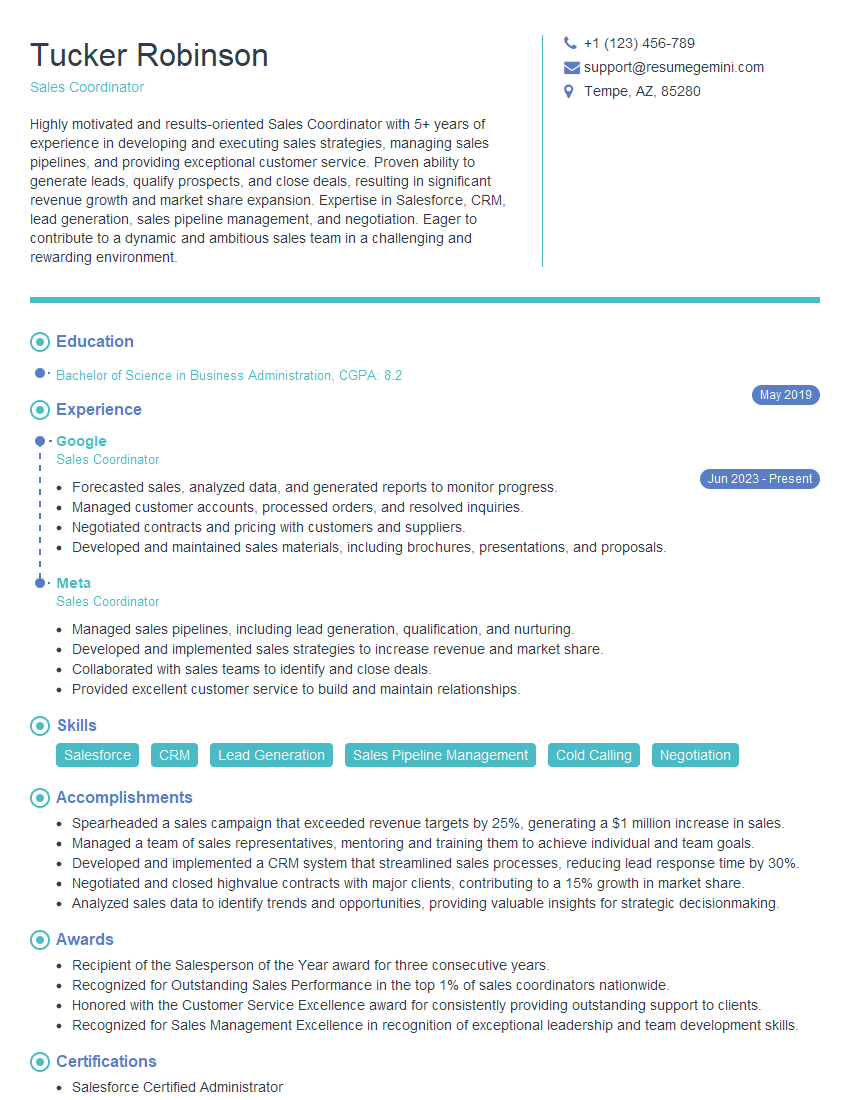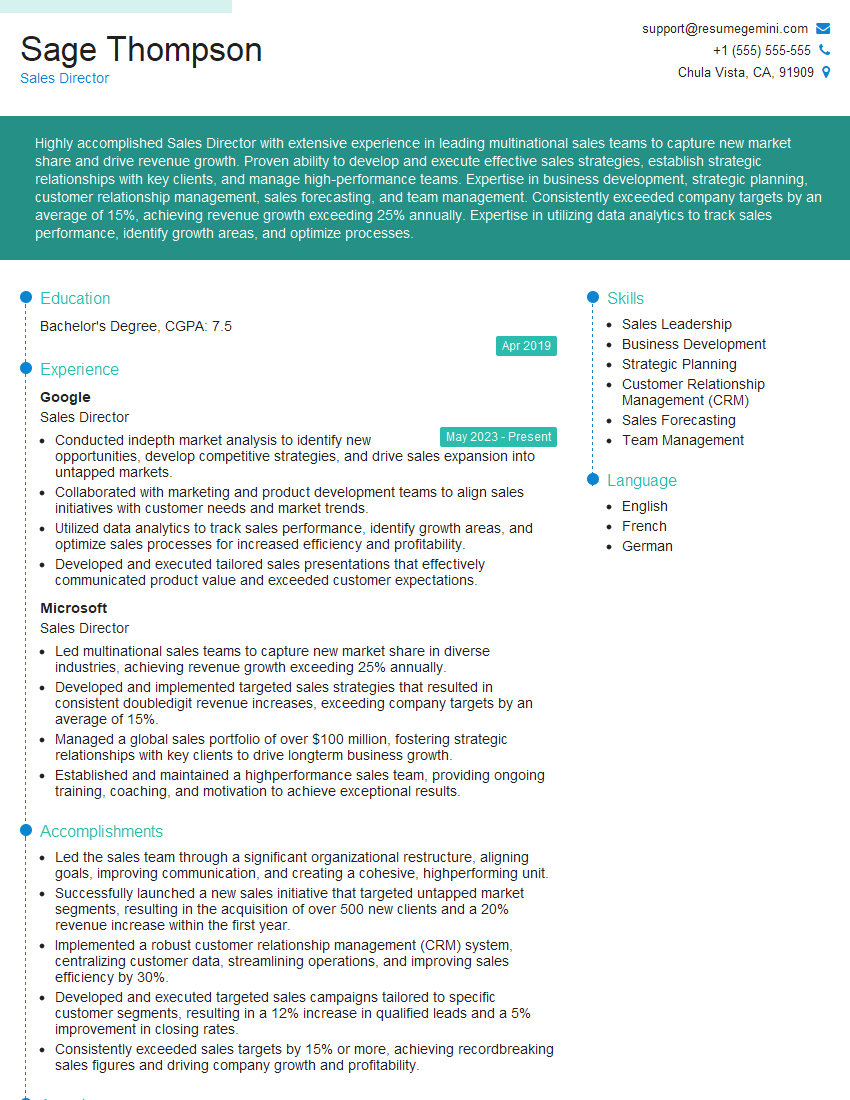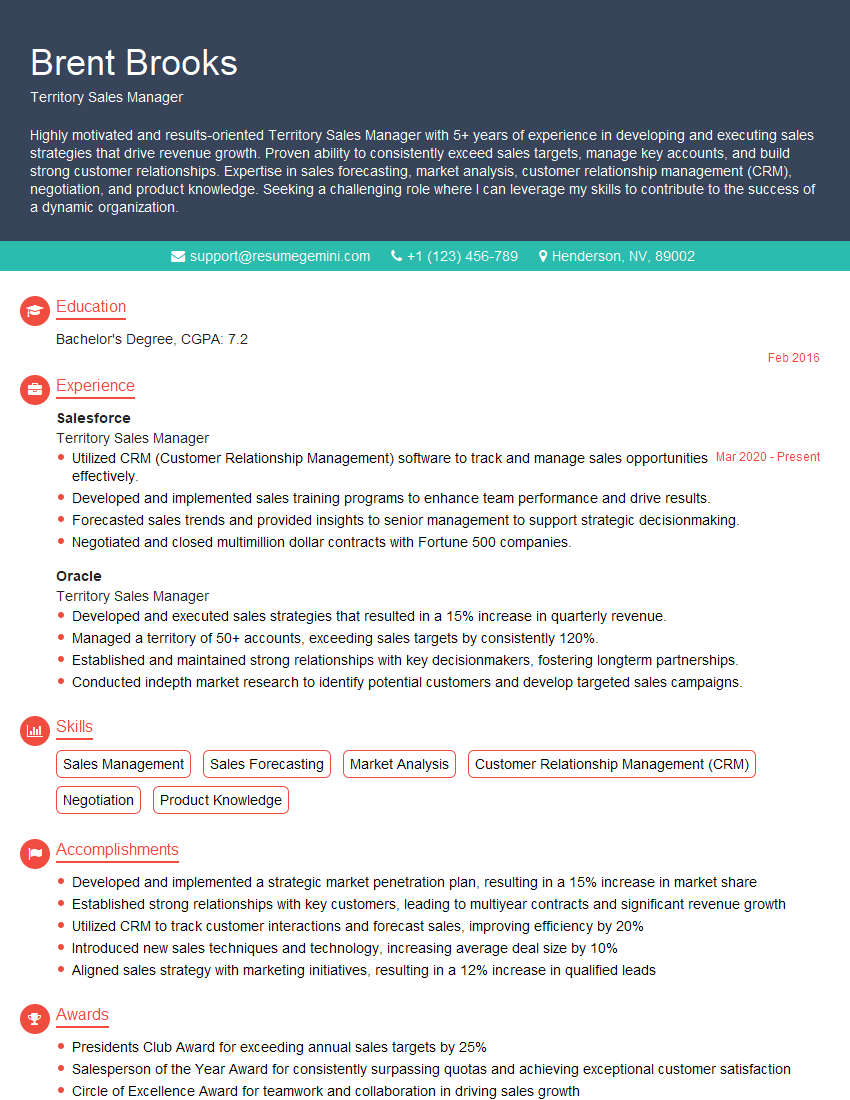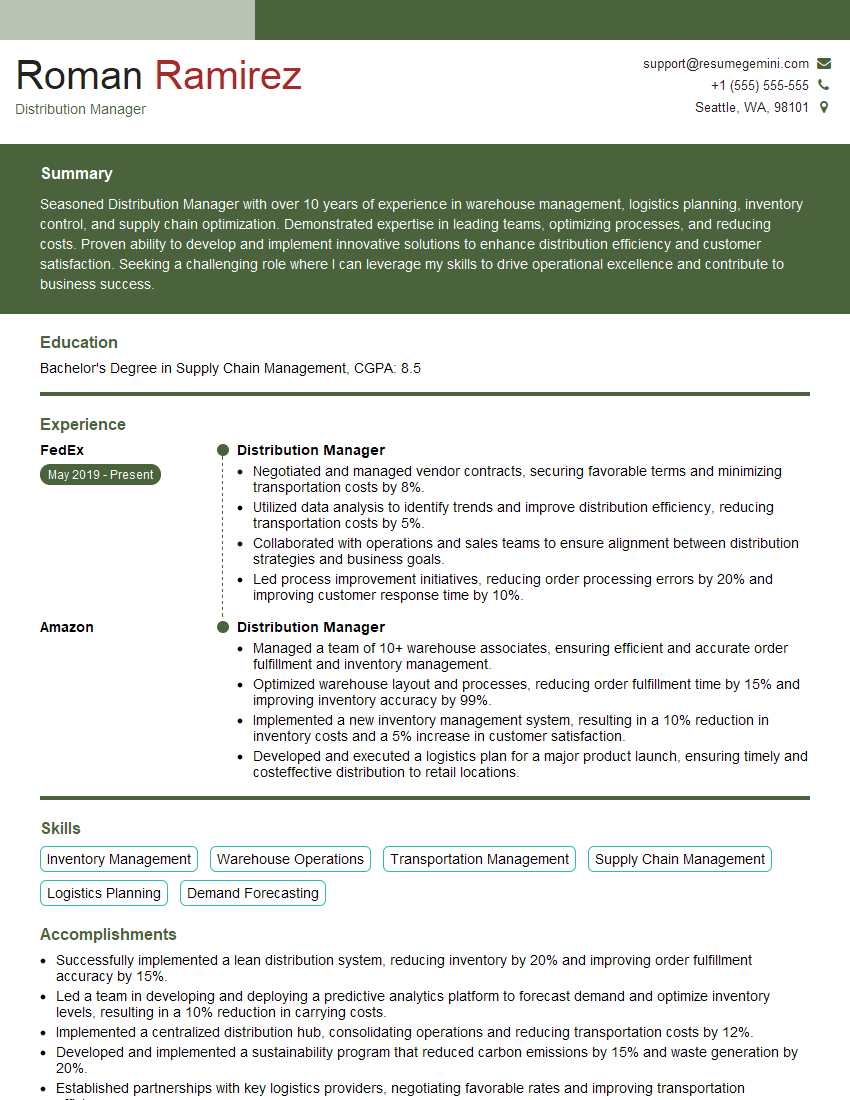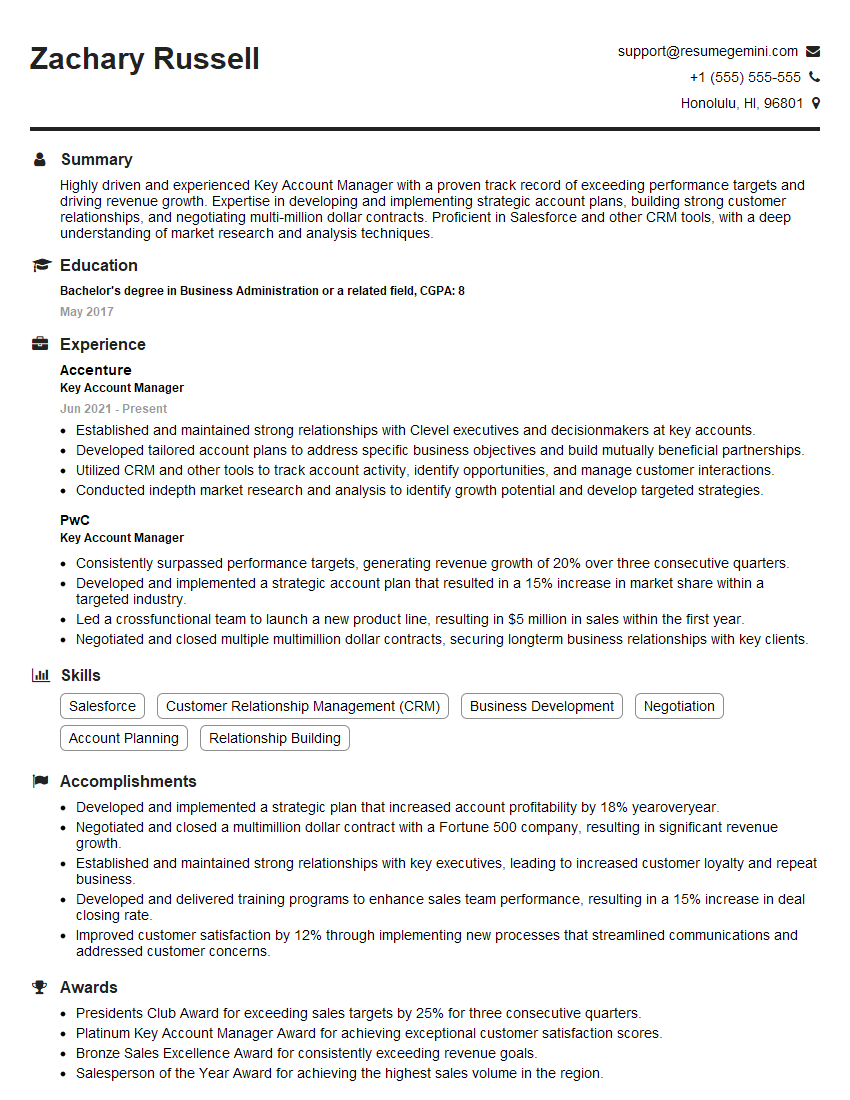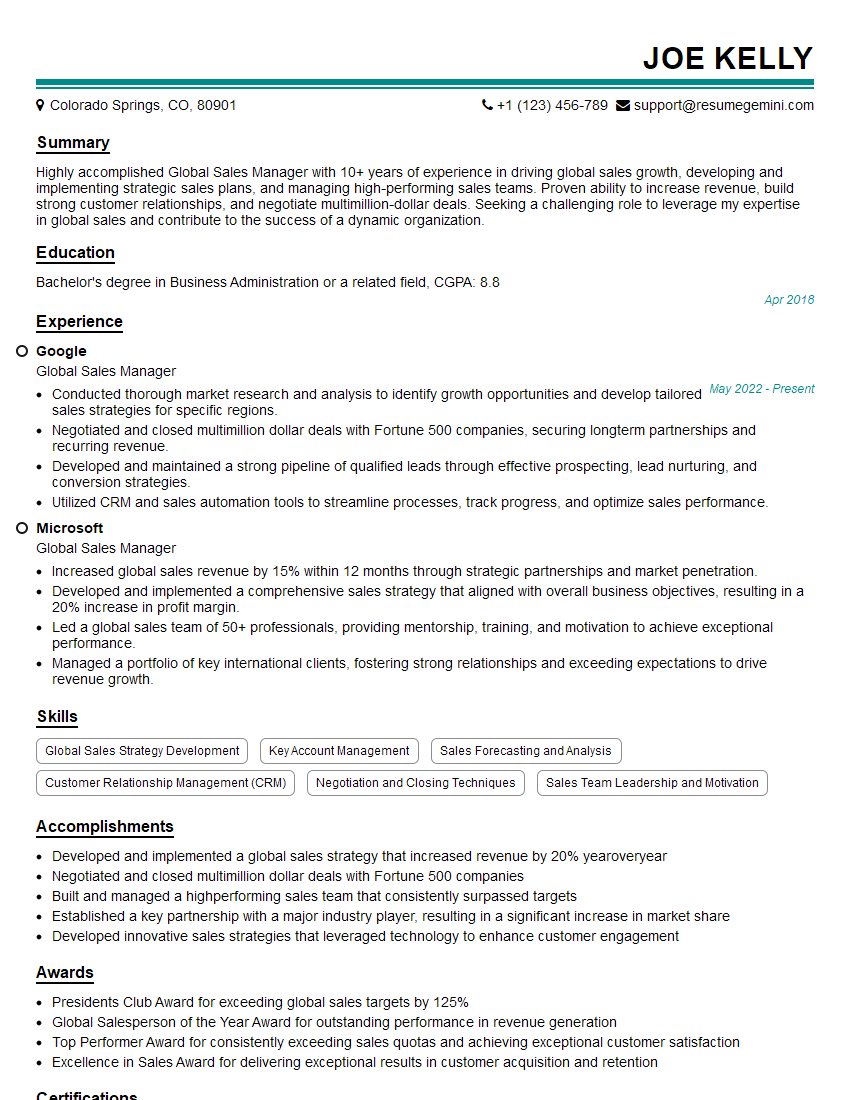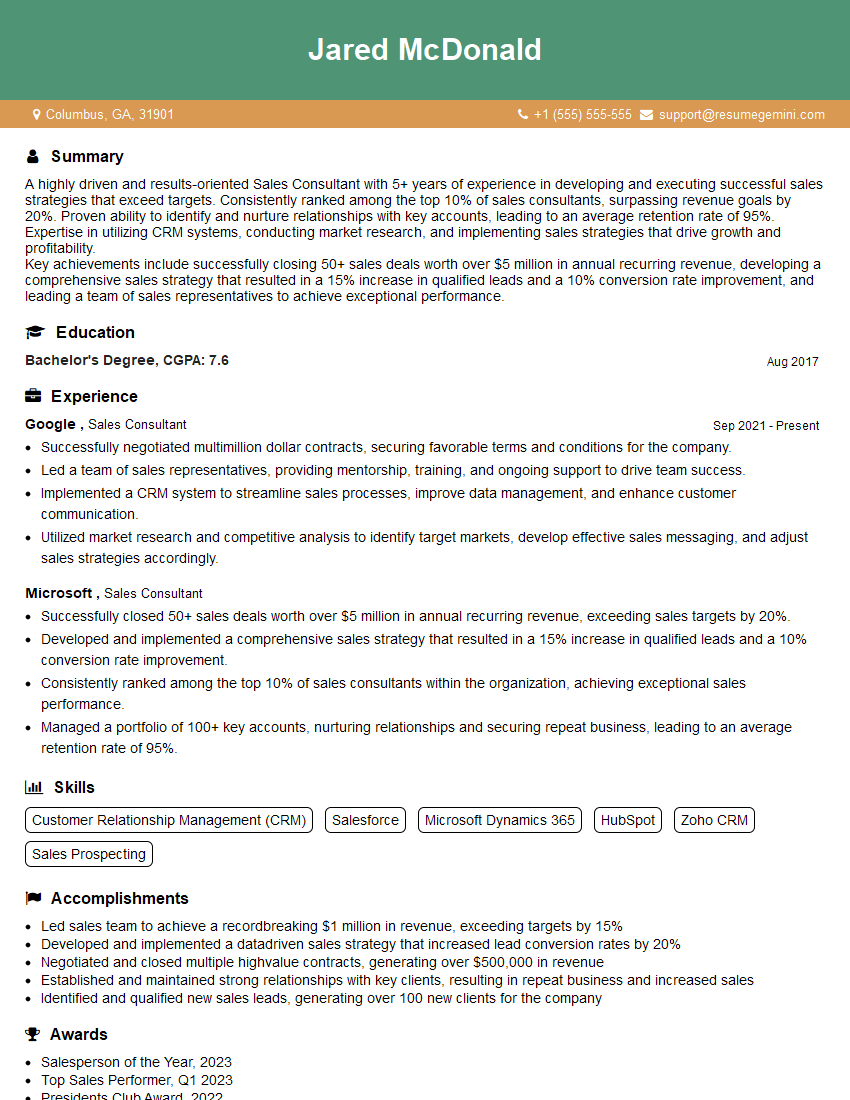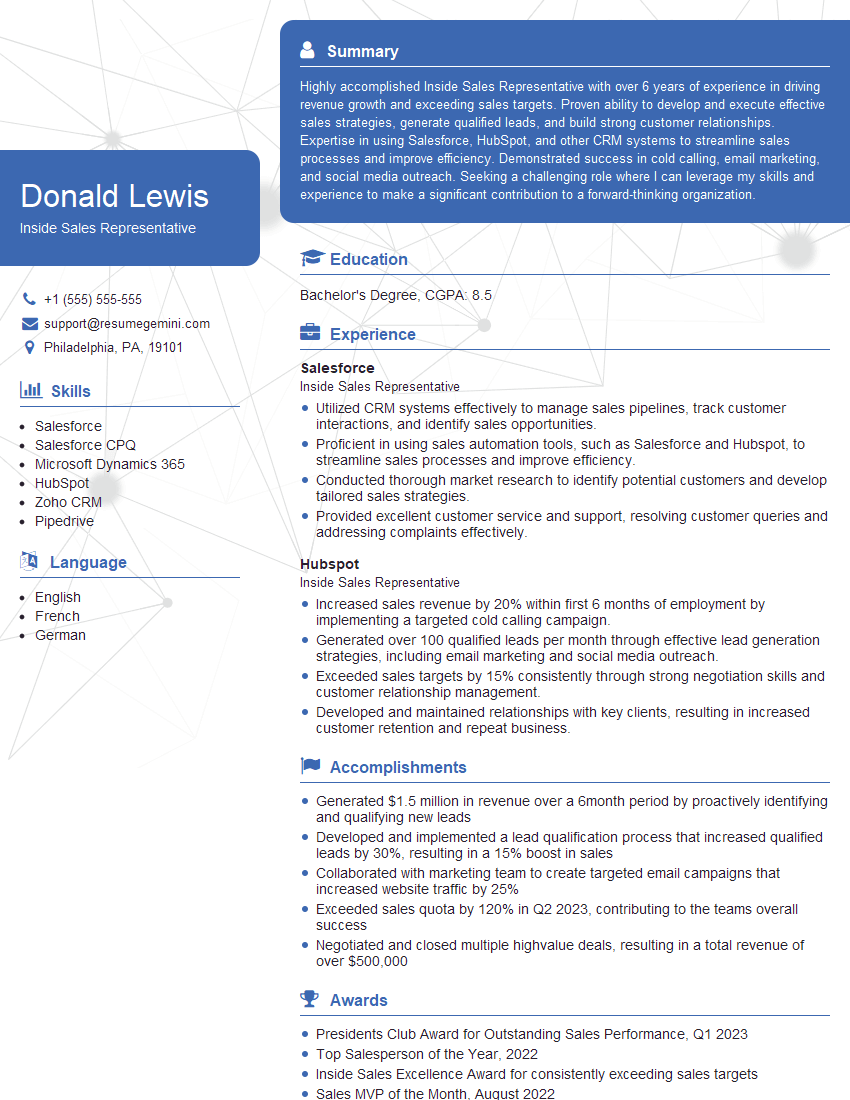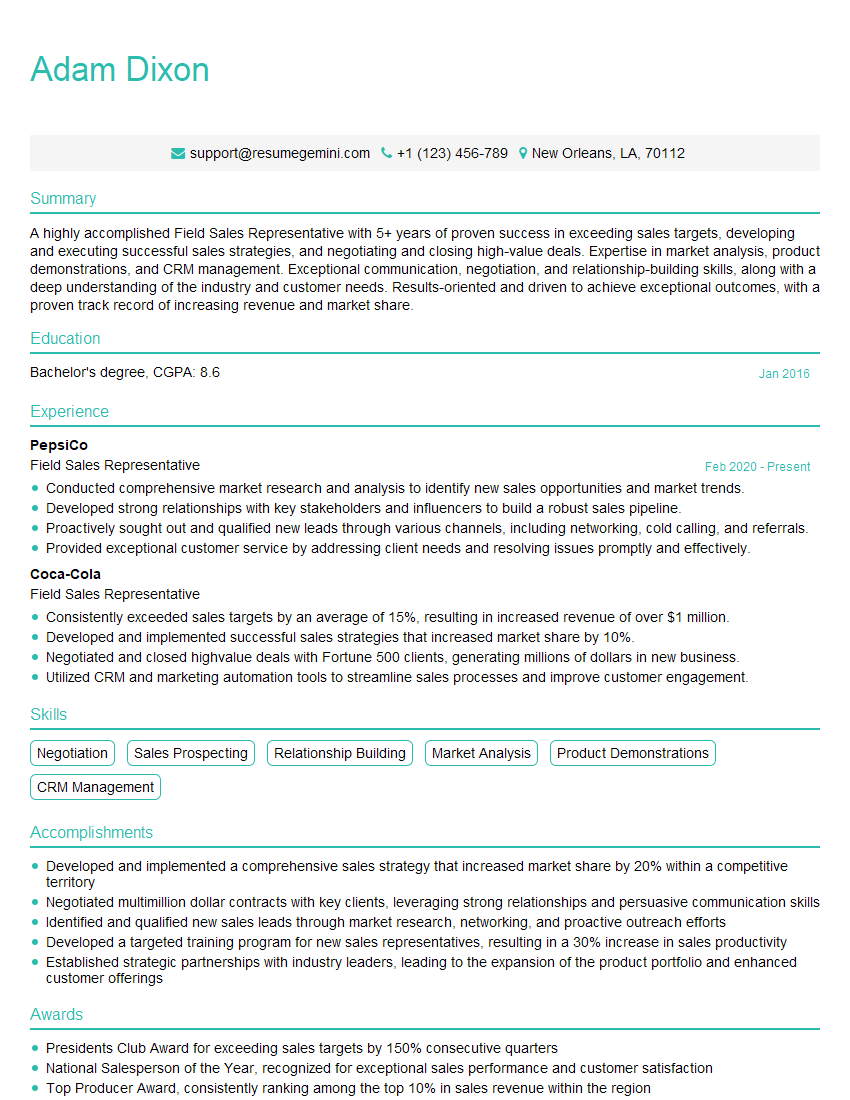Cracking a skill-specific interview, like one for Sales and Distribution, requires understanding the nuances of the role. In this blog, we present the questions you’re most likely to encounter, along with insights into how to answer them effectively. Let’s ensure you’re ready to make a strong impression.
Questions Asked in Sales and Distribution Interview
Q 1. Describe your experience in managing sales targets and achieving KPIs.
Managing sales targets and achieving KPIs is the cornerstone of successful sales leadership. It requires a strategic approach that blends meticulous planning, effective execution, and constant monitoring. My experience involves setting realistic yet challenging targets, breaking them down into smaller, manageable milestones, and aligning them with overall company objectives. I utilize various methods to track progress, including dashboards that visualize key performance indicators (KPIs) like conversion rates, average deal size, and customer acquisition cost.
For example, in my previous role at Acme Corp, we were tasked with increasing sales by 15% within a fiscal year. Instead of focusing solely on the overall target, we segmented our customer base and set individual targets for each segment, taking into account factors like customer lifetime value and market potential. This allowed for more focused effort and accountability. We used a combination of sales contests, personalized coaching, and data-driven insights to boost performance. Regular review meetings provided valuable feedback and adjustments to strategies. Ultimately, we surpassed the 15% target by 8%, exceeding expectations and demonstrating the effectiveness of a well-structured, data-driven approach.
Q 2. How do you handle challenging clients or customer complaints?
Handling challenging clients and customer complaints requires empathy, patience, and a structured approach. My first step is always to actively listen to the customer’s concerns without interruption. I strive to understand their perspective and acknowledge their feelings. This demonstrates respect and helps build rapport.
Next, I work to identify the root cause of the problem. Is it a product defect? A communication breakdown? A misunderstanding of our services? Once identified, I propose a solution that addresses the customer’s immediate needs while preventing similar issues in the future. This might involve offering a refund, providing a replacement product, or adjusting our internal processes.
For example, a client once complained about a delay in delivery due to a logistical error. Instead of becoming defensive, I apologized for the inconvenience, explained the cause of the delay, and offered a complimentary service to compensate for their trouble. This approach turned a potentially negative experience into a positive one, strengthening our relationship. Documentation of each complaint and its resolution is crucial for identifying patterns and implementing proactive solutions.
Q 3. Explain your approach to forecasting sales and managing inventory.
Forecasting sales and managing inventory are intertwined processes that require a keen understanding of market trends, sales history, and economic factors. My approach relies on a multi-faceted strategy that combines qualitative and quantitative methods.
I begin by analyzing historical sales data, identifying seasonal patterns, and tracking key economic indicators. This quantitative analysis forms the foundation of my forecast. I then incorporate qualitative insights, such as market research, customer feedback, and competitor analysis, to refine the forecast and account for unforeseen events. The resulting forecast is then used to optimize inventory levels. I use inventory management software to track stock levels, predict demand fluctuations, and minimize storage costs. The goal is to maintain sufficient inventory to meet customer demand without incurring excessive holding costs or facing stockouts.
For example, anticipating increased demand during the holiday season, I would analyze previous years’ sales data, project future growth based on market trends, and adjust our inventory levels accordingly. This proactive approach minimizes the risk of stockouts and maximizes sales opportunities.
Q 4. What sales methodologies are you familiar with, and which do you prefer?
I’m familiar with various sales methodologies, including Solution Selling, Consultative Selling, and Challenger Sale. However, my preference depends on the specific situation and customer profile.
Solution Selling is ideal for complex sales cycles involving high-value products or services where the customer needs a customized solution. Consultative Selling is effective when building trust and long-term relationships is paramount. The Challenger Sale approach, though potentially more confrontational, can be highly effective when dealing with sophisticated clients who value insightful, thought-provoking challenges to the status quo. Often, I employ a hybrid approach, adapting my style to suit the individual needs of each customer.
In practice, I often begin with a consultative approach to understand the client’s needs, then transition to solution selling to present tailored options. The level of challenge introduced depends heavily on the client’s receptiveness and their experience with similar solutions. My ultimate goal is to create a win-win situation that benefits both the client and the company.
Q 5. Describe your experience with CRM software and its application in sales.
CRM software is an indispensable tool for managing sales processes and customer relationships. My experience with CRM systems, including Salesforce and HubSpot, involves using them to manage leads, track sales activities, analyze sales data, and improve customer interactions. I’m proficient in using CRM functionalities such as contact management, opportunity tracking, pipeline analysis, and reporting.
I utilize CRM data to identify sales trends, pinpoint areas for improvement, and personalize customer interactions. For instance, I use CRM-generated reports to monitor sales performance against targets, identify top-performing sales representatives, and segment customer bases for targeted marketing campaigns. The automation features of CRM systems greatly reduce administrative tasks, allowing me to focus more time on strategic activities and customer engagement. Proper data hygiene is critical; ensuring data accuracy in the CRM system is paramount for generating reliable insights and making informed business decisions.
Q 6. How do you identify and prioritize new sales opportunities?
Identifying and prioritizing new sales opportunities requires a proactive and strategic approach. I employ various techniques to uncover potential leads, including market research, networking, lead generation campaigns, and analyzing existing customer data.
My process involves evaluating the potential of each opportunity based on factors such as customer size, industry, and potential revenue. I prioritize opportunities based on their likelihood of closing and their potential impact on the overall sales goals. This typically involves using a scoring system that weights different factors, such as lead qualification criteria and estimated deal size.
For instance, a potential customer in a high-growth industry with a substantial budget might receive a higher priority than a smaller customer in a less dynamic market. This prioritization ensures that my efforts are focused on the opportunities most likely to generate significant returns.
Q 7. What strategies do you use to build and maintain strong customer relationships?
Building and maintaining strong customer relationships is crucial for long-term success. My strategy focuses on providing exceptional customer service, fostering open communication, and demonstrating genuine care for their needs.
I proactively engage with customers, not just when a sale is pending. Regular follow-ups, personalized communication, and providing valuable resources build trust and loyalty. I actively seek feedback to improve our products or services and address any concerns promptly. I also strive to create a personalized experience, tailoring interactions to meet individual customer preferences and needs. This approach helps build long-lasting relationships that benefit both the customer and the company.
For example, sending personalized birthday messages or sharing relevant industry insights demonstrates a genuine interest in maintaining the relationship beyond transactional interactions. This creates loyalty and increases the likelihood of repeat business and positive referrals.
Q 8. Explain your understanding of the sales cycle and its various stages.
The sales cycle is the series of steps a salesperson takes to convert a prospect into a paying customer. Think of it as a journey, with each stage bringing the customer closer to a purchase. A typical sales cycle includes several key stages:
- Prospecting: Identifying and qualifying potential customers. This involves research, networking, and lead generation.
- Initiation of contact: Reaching out to prospects through various channels (email, phone, social media) and introducing your product or service.
- Needs Analysis: Understanding the prospect’s needs and pain points to determine if your product is a good fit. This is crucial for tailoring your sales pitch.
- Presentation: Demonstrating your product’s value proposition and showing how it solves the prospect’s problems. This involves clear communication and effective storytelling.
- Handling Objections: Addressing any concerns or hesitations the prospect may have. This requires skillful listening and persuasive negotiation.
- Closing: Asking for the sale and guiding the prospect towards a purchase decision. This is the culmination of the entire process.
- Follow-up: Maintaining contact with the customer post-sale to ensure satisfaction and build a long-term relationship. This fosters loyalty and repeat business.
For example, in selling enterprise software, prospecting might involve attending industry conferences, while closing might involve negotiating a complex contract. Each stage requires a different skillset and approach.
Q 9. How do you measure the effectiveness of your sales strategies?
Measuring sales strategy effectiveness is vital for continuous improvement. I use a combination of quantitative and qualitative metrics. Quantitatively, I track:
- Revenue Growth: The most straightforward metric, measuring the overall increase in sales revenue over a specific period.
- Conversion Rates: Tracking the percentage of prospects who move from one stage of the sales cycle to the next. For example, the percentage of leads who become qualified leads, or the percentage of qualified leads who become customers.
- Average Deal Size: The average revenue generated per sale. This can reveal opportunities to upsell or cross-sell.
- Sales Cycle Length: The time it takes to close a deal. Reducing this length improves efficiency and profitability.
Qualitatively, I gather feedback through:
- Customer Surveys: Understanding customer satisfaction and identifying areas for improvement.
- Sales Team Feedback: Getting insights from salespeople on what’s working and what isn’t in the field.
- Market Research: Staying updated on industry trends and competitor activities.
By analyzing these metrics, I can identify areas of strength and weakness in our sales strategies and make data-driven adjustments.
Q 10. How do you manage a sales team and motivate individuals to reach their goals?
Managing a sales team requires a blend of leadership, coaching, and support. I believe in a collaborative and empowering approach. My strategy includes:
- Clear Goal Setting: Establishing SMART (Specific, Measurable, Achievable, Relevant, Time-bound) goals for each team member and the team as a whole.
- Regular Training and Development: Providing ongoing training on sales techniques, product knowledge, and industry best practices.
- Effective Communication: Maintaining open communication channels, providing regular feedback, and encouraging team members to share their challenges and successes.
- Performance Monitoring and Coaching: Regularly tracking individual and team performance, providing constructive feedback, and offering tailored coaching to address any shortcomings.
- Incentive Programs: Implementing reward systems to recognize and motivate high-performing individuals and the team as a whole. This could include commissions, bonuses, or other forms of recognition.
- Building Team Cohesion: Fostering a supportive and collaborative team environment where team members feel valued and respected.
For example, I might implement a mentorship program pairing experienced salespeople with newer team members, or host team-building activities to strengthen relationships.
Q 11. Describe your experience with different distribution channels.
My experience encompasses a range of distribution channels, including:
- Direct Sales: Selling directly to customers through a company’s own sales force. This provides maximum control but can be costly.
- Indirect Sales: Utilizing intermediaries like distributors, wholesalers, and retailers to reach customers. This expands reach but requires managing relationships with multiple partners.
- E-commerce: Selling products or services online through a company website or online marketplaces like Amazon. This offers 24/7 accessibility and global reach.
- Value-Added Resellers (VARs): Partnering with companies that add value to products before reselling them. This can extend reach to specialized markets.
- Franchising: Granting independent businesses the right to sell products or services under the company’s brand. This allows for rapid expansion with limited investment.
In a previous role, I successfully transitioned a company from a primarily direct sales model to a multi-channel approach leveraging e-commerce and a network of distributors, significantly increasing market penetration.
Q 12. Explain how you optimize the distribution network for efficiency and cost-effectiveness.
Optimizing the distribution network involves balancing efficiency and cost-effectiveness. My approach includes:
- Network Design: Analyzing current distribution channels and identifying areas for improvement, considering factors like location, transportation costs, and inventory management.
- Inventory Management: Implementing strategies to maintain optimal inventory levels, minimizing storage costs while ensuring timely product availability. This might involve using inventory management software and forecasting techniques.
- Transportation Optimization: Selecting efficient transportation modes and routes to minimize shipping costs and delivery times. This could involve negotiating better rates with carriers or employing route optimization software.
- Warehouse Management: Optimizing warehouse operations for efficient storage, order fulfillment, and inventory control. This includes effective space utilization and efficient order picking processes.
- Technology Integration: Leveraging technology such as Warehouse Management Systems (WMS) and Transportation Management Systems (TMS) to improve visibility, track shipments, and automate processes.
For instance, I might analyze delivery routes using mapping software to identify more efficient pathways, reducing fuel costs and delivery times. Or I might implement a just-in-time inventory system to minimize warehousing costs.
Q 13. How do you manage logistics and ensure timely delivery of goods?
Managing logistics and ensuring timely delivery requires a robust and well-coordinated system. My approach involves:
- Order Processing: Establishing efficient order processing procedures to ensure accurate and timely order fulfillment.
- Warehouse Management: Utilizing a Warehouse Management System (WMS) to track inventory, manage orders, and optimize warehouse operations.
- Transportation Management: Selecting appropriate transportation modes (truck, rail, air, sea) and carriers based on cost, speed, and reliability. Employing a Transportation Management System (TMS) for route optimization and shipment tracking.
- Real-time Tracking: Using GPS tracking and other technologies to monitor shipments in real-time and proactively address any potential delays.
- Communication and Coordination: Maintaining clear communication with carriers, warehouses, and customers to ensure seamless coordination throughout the delivery process.
- Risk Management: Developing contingency plans to mitigate potential disruptions, such as inclement weather or unforeseen delays.
For example, we might implement a system that automatically alerts customers of any delays and provides estimated delivery times, improving transparency and customer satisfaction.
Q 14. What is your approach to solving distribution-related challenges?
My approach to solving distribution-related challenges is systematic and data-driven. I typically follow these steps:
- Identify the Problem: Clearly define the challenge, gathering data to understand its scope and impact.
- Analyze the Root Cause: Investigate the underlying factors contributing to the problem. This might involve analyzing delivery times, customer complaints, or inventory levels.
- Develop Solutions: Brainstorm potential solutions based on the root cause analysis. This might involve process improvements, technological upgrades, or changes in logistics strategies.
- Implement and Test: Implement the chosen solution on a pilot basis, monitoring its effectiveness closely.
- Evaluate and Refine: Analyze the results of the pilot program, making adjustments as needed to optimize the solution’s performance.
- Scale and Monitor: Once the solution proves effective, scale it across the distribution network, continuing to monitor its performance and making any necessary adjustments.
For instance, if facing high delivery costs, I might analyze delivery routes to identify inefficiencies, negotiate better rates with carriers, or explore alternative transportation modes.
Q 15. How do you handle inventory management and avoid stockouts or overstocking?
Effective inventory management is the backbone of successful sales and distribution. It’s about striking the perfect balance – avoiding stockouts that lose sales and overstocking that ties up capital and increases storage costs. My approach involves a multi-pronged strategy:
- Demand Forecasting: I leverage historical sales data, market trends, seasonality, and promotional plans to accurately predict future demand. This often involves using statistical models and collaborating with the marketing team to understand upcoming campaigns.
- Inventory Control Systems: Implementing a robust inventory management system, often integrated with a Warehouse Management System (WMS), is crucial. This allows for real-time tracking of stock levels, automating reordering processes, and providing accurate insights into inventory turnover rates.
- Safety Stock Calculation: Determining the appropriate safety stock is vital to buffer against unexpected demand surges or supply chain disruptions. This calculation considers lead times, demand variability, and service level targets.
- Regular Inventory Audits: Physical inventory counts are conducted regularly to reconcile the physical stock with the system records, ensuring accuracy and identifying discrepancies early on.
- ABC Analysis: Categorizing inventory items based on their value and consumption rate (A – high value, high consumption; B – medium; C – low) allows for focused management of critical items and optimization of storage and ordering strategies. For example, ‘A’ items require more stringent monitoring and tighter control than ‘C’ items.
For example, in my previous role, we implemented a forecasting model that reduced stockouts by 15% and overstocking by 10% within six months, leading to a significant improvement in profitability.
Career Expert Tips:
- Ace those interviews! Prepare effectively by reviewing the Top 50 Most Common Interview Questions on ResumeGemini.
- Navigate your job search with confidence! Explore a wide range of Career Tips on ResumeGemini. Learn about common challenges and recommendations to overcome them.
- Craft the perfect resume! Master the Art of Resume Writing with ResumeGemini’s guide. Showcase your unique qualifications and achievements effectively.
- Don’t miss out on holiday savings! Build your dream resume with ResumeGemini’s ATS optimized templates.
Q 16. What metrics do you use to monitor the performance of your distribution operations?
Monitoring distribution performance requires a suite of key performance indicators (KPIs). I regularly track metrics such as:
- Order Fulfillment Rate: The percentage of orders fulfilled on time and in full. This is a critical measure of operational efficiency.
- On-Time Delivery Rate: The percentage of orders delivered within the promised timeframe, reflecting the reliability of the distribution process.
- Inventory Turnover Rate: The number of times inventory is sold and replaced over a specific period. A higher rate indicates efficient inventory management.
- Distribution Costs: Tracking warehousing, transportation, and handling costs helps to identify areas for cost optimization and improvement.
- Perfect Order Rate: The percentage of orders that are processed and delivered without any errors, encompassing aspects like accuracy, completeness, and timely delivery. This KPI gives a holistic view of distribution effectiveness.
- Customer Satisfaction: Gathering feedback from customers through surveys and reviews is essential to identify areas needing improvement in the distribution process.
By regularly reviewing these KPIs, we can identify bottlenecks, pinpoint areas for improvement, and make data-driven decisions to optimize the distribution network.
Q 17. Describe your experience with warehouse management systems.
I have extensive experience with Warehouse Management Systems (WMS), having implemented and managed several in different organizational contexts. My experience includes:
- System Selection and Implementation: I’ve been involved in selecting, configuring, and implementing WMS solutions tailored to specific business needs, ensuring seamless integration with existing ERP systems. This involves careful assessment of features, vendor capabilities, and cost-benefit analysis.
- Process Optimization: I’ve utilized WMS functionalities to optimize warehouse operations, improving efficiency in receiving, putaway, picking, packing, and shipping. This can involve re-engineering warehouse layouts and implementing strategies like wave picking or zone picking.
- Data Analysis and Reporting: WMS provides rich data on warehouse performance. I’ve leveraged this data to identify areas for improvement, track KPIs, and generate reports for management review.
- Training and Support: I’ve been involved in training warehouse staff on the use of WMS, ensuring that they understand the system and can effectively use its features. Ongoing support and troubleshooting are also crucial for successful WMS implementation.
For example, in a previous role, we implemented a new WMS that reduced order fulfillment time by 20% and improved picking accuracy by 10%.
Q 18. How do you ensure the quality and security of products throughout the distribution process?
Maintaining product quality and security throughout the distribution process is paramount. This involves a multi-layered approach:
- Proper Packaging and Handling: Using appropriate packaging materials and following standardized handling procedures minimizes damage during transit. This includes utilizing protective packaging, labeling clearly, and providing specific handling instructions.
- Temperature Control (if applicable): For temperature-sensitive products, maintaining the correct temperature throughout the supply chain is critical. This may involve using refrigerated trucks and warehouses.
- Security Measures: Implementing robust security measures, such as access control systems, surveillance cameras, and inventory tracking, helps prevent theft and loss. This also includes securing transport vehicles and monitoring shipments.
- Quality Control Checks: Regularly inspecting inventory at various points in the distribution network identifies potential quality issues early on. This could involve visual inspections, random sampling, and testing.
- Traceability: Maintaining accurate records of product movement allows us to quickly trace the origin of any problems or recalls. This often involves using barcodes or RFID tags.
For instance, we once implemented a new tracking system that allowed us to pinpoint a batch of faulty products quickly, preventing widespread customer dissatisfaction and potential recalls.
Q 19. Explain your understanding of supply chain management.
Supply chain management (SCM) encompasses the entire process of planning, sourcing, producing, and delivering products to customers. It’s a holistic approach that integrates various functions across different organizations, from raw material suppliers to end consumers. My understanding of SCM includes:
- Strategic Planning: Defining the overall goals and strategies for the supply chain, considering factors like capacity planning, risk management, and sustainability.
- Sourcing and Procurement: Selecting and managing suppliers, negotiating contracts, and ensuring timely delivery of materials.
- Production and Manufacturing: Optimizing the manufacturing process to meet demand while minimizing costs and maximizing efficiency.
- Inventory Management: Balancing inventory levels to minimize storage costs while avoiding stockouts.
- Distribution and Logistics: Efficiently transporting and delivering products to customers, managing warehousing, transportation, and handling.
- Customer Service: Addressing customer inquiries, handling returns, and ensuring customer satisfaction.
Effective SCM requires strong collaboration and information sharing across all stages of the supply chain. It’s about creating a seamless flow of goods and information to deliver exceptional value to the customer.
Q 20. How do you collaborate with other departments to achieve sales and distribution goals?
Collaboration is key to achieving sales and distribution goals. I actively collaborate with various departments including:
- Sales Team: Close collaboration with the sales team is essential for accurate demand forecasting and aligning distribution capabilities with sales targets. This involves regular communication regarding sales forecasts, promotional plans, and customer needs.
- Marketing Team: Understanding marketing campaigns is crucial for anticipating demand fluctuations and ensuring sufficient inventory levels to support promotional activities. This includes aligning distribution timelines with marketing launches.
- Procurement Team: Close coordination with procurement ensures timely acquisition of raw materials and supplies to meet production needs. This requires clear communication regarding inventory levels and projected demand.
- Operations Team: Effective communication with the operations team ensures efficient warehouse operations, optimized transportation routes, and timely order fulfillment. This involves sharing data on inventory levels, order volumes, and delivery schedules.
- Finance Team: Collaboration with the finance team is necessary to manage distribution costs, track inventory valuation, and ensure compliance with financial regulations. This includes reporting on key metrics and budget management.
By fostering open communication and shared goals, we can create a cohesive and efficient system that delivers superior results.
Q 21. Describe a time you had to deal with a significant distribution problem. What was your solution?
In a previous role, we experienced a significant distribution problem when a major supplier experienced an unexpected production delay, causing a critical shortage of a key component for our flagship product. This threatened to disrupt our sales and damage our reputation.
My solution involved a multi-step approach:
- Damage Control: I immediately communicated the situation to the sales team, adjusting sales forecasts and managing customer expectations. Transparency and proactive communication were vital.
- Alternative Sourcing: We urgently explored alternative suppliers for the component, evaluating their capabilities and lead times. This involved extensive research and negotiations.
- Prioritization and Allocation: We prioritized existing orders based on customer importance and lead time, ensuring critical orders were fulfilled first. This required careful allocation of the limited available inventory.
- Expedited Shipping: To expedite the delivery of the component from the alternative supplier, we negotiated faster shipping options, absorbing the higher costs to minimize the disruption.
- Process Review: Following the resolution, we reviewed our supply chain strategy, identifying vulnerabilities and implementing contingency plans to mitigate similar risks in the future. This involved diversifying our supplier base and developing more robust inventory buffer strategies.
By swiftly implementing these solutions, we minimized the impact of the supplier delay, maintaining customer satisfaction and preserving our reputation. The incident also highlighted the importance of proactive risk management and diversified sourcing in supply chain resilience.
Q 22. What is your experience with sales reporting and data analysis?
My experience with sales reporting and data analysis is extensive. I’m proficient in extracting, cleaning, and analyzing sales data from various sources, including CRM systems (like Salesforce or HubSpot), ERP systems, and marketing automation platforms. I utilize tools such as Excel, SQL, and data visualization software like Tableau or Power BI to transform raw data into actionable insights. For example, in my previous role at Acme Corp, I identified a 15% drop in sales of our flagship product in the Southern region by analyzing sales figures alongside marketing campaign data. This allowed us to pinpoint the problem – a poorly targeted marketing campaign – and implement corrective measures, resulting in a 10% sales uplift within the next quarter. My analytical skills extend beyond simple reporting; I regularly delve into trend analysis, forecasting, and identifying key performance indicators (KPIs) that drive strategic decision-making. I’m comfortable presenting my findings to both technical and non-technical audiences, translating complex data into clear, concise recommendations.
Q 23. How do you stay up-to-date on industry trends and best practices?
Staying current in the dynamic sales and distribution landscape requires a multifaceted approach. I actively participate in industry conferences and webinars, subscribing to relevant trade publications like Sales & Marketing Management and Distribution Strategy. I also actively engage with online communities and professional networks like LinkedIn, following thought leaders and participating in discussions. Furthermore, I dedicate time to research and review industry reports and analyses from reputable sources such as Gartner and Forrester. This continuous learning ensures I’m abreast of the latest technological advancements (like AI-powered sales tools), emerging market trends, and best practices in sales strategies, supply chain management, and customer relationship management. It’s not just about passively consuming information; I actively seek out new methodologies and frameworks to test and implement in my work, constantly seeking improvement and optimization.
Q 24. How do you adapt your sales and distribution strategies to different market conditions?
Adaptability is paramount in sales and distribution. My approach hinges on a deep understanding of market dynamics. I begin by conducting thorough market research to assess factors like economic conditions, competitive landscape, consumer behavior, and regulatory changes. For instance, during a recent economic downturn, I shifted our focus from high-priced products to more affordable options, simultaneously optimizing our distribution network to reduce costs. This involved renegotiating contracts with logistics providers and exploring alternative distribution channels, like e-commerce platforms. In other scenarios, I’ve adapted by adjusting pricing strategies, intensifying marketing efforts in specific geographic areas, or introducing new product lines to cater to evolving customer needs. The key is to remain agile, constantly monitoring market signals and proactively adjusting strategies to maintain competitiveness and profitability. Essentially, I treat my sales and distribution strategies as living documents, subject to constant revision and improvement based on real-time data and market feedback.
Q 25. What are your salary expectations for this role?
My salary expectations are commensurate with my experience, skills, and the responsibilities of this role. Based on my research and understanding of the current market rates for similar positions, I’m targeting a salary range of [Insert Salary Range]. However, I am open to discussing this further, taking into consideration the full compensation package, including benefits and potential for growth within the company.
Q 26. What are your career aspirations?
My career aspirations revolve around progressively increasing responsibility and impact within the sales and distribution field. I envision myself in a leadership role, mentoring and guiding teams to achieve ambitious sales targets and excel in strategic planning. Specifically, I aim to hone my expertise in developing and implementing innovative sales strategies and building high-performing sales teams. I am particularly interested in exploring opportunities to leverage data analytics and technology to further optimize sales processes and gain a competitive edge. Ultimately, I strive to contribute to the overall success of an organization through effective sales leadership and strategic business development.
Q 27. Why are you interested in this specific opportunity?
I am highly interested in this opportunity because [Company Name]’s reputation for innovation and commitment to its employees strongly aligns with my professional values. The opportunity to contribute to [Specific project or team mentioned in job description] particularly excites me, given my experience in [Relevant skill or experience]. Furthermore, I’m drawn to the company’s [Mention company culture or mission statement – something specific that resonates with you]. I believe my skills and experience make me a strong candidate to make significant contributions to your team and contribute to the overall success of [Company Name].
Q 28. Do you have any questions for me?
Yes, I do have a few questions. First, could you elaborate on the specific challenges the team is currently facing? Second, what opportunities are there for professional development and advancement within the company? Finally, what are the key metrics used to measure success in this role?
Key Topics to Learn for Sales and Distribution Interview
- Understanding Market Dynamics: Analyze market trends, competitive landscapes, and customer segmentation to inform strategic sales and distribution planning. Practical application: Develop a market entry strategy for a new product.
- Sales Forecasting and Planning: Master techniques for accurate sales forecasting, inventory management, and resource allocation. Practical application: Build a sales forecast model based on historical data and market projections.
- Distribution Channel Management: Explore various distribution channels (direct sales, wholesalers, retailers, e-commerce) and their suitability for different products and markets. Practical application: Evaluate the cost-effectiveness and reach of different distribution channels.
- Supply Chain Optimization: Understand the complexities of supply chain management, including logistics, warehousing, and inventory control. Practical application: Identify bottlenecks in a supply chain and propose solutions for improvement.
- Sales Strategies and Techniques: Learn about different sales methodologies (e.g., consultative selling, solution selling) and their application in various contexts. Practical application: Develop a sales pitch for a specific product or service.
- Customer Relationship Management (CRM): Understand the importance of CRM systems for managing customer interactions, tracking sales data, and improving customer satisfaction. Practical application: Describe how a CRM system can enhance sales performance and customer loyalty.
- Data Analysis and Reporting: Develop skills in analyzing sales data, identifying trends, and creating effective reports to track progress and inform decision-making. Practical application: Interpret key performance indicators (KPIs) and make data-driven recommendations.
- Negotiation and Closing Techniques: Develop strong negotiation skills to secure favorable deals and close sales effectively. Practical application: Prepare for a role-play scenario involving a negotiation with a potential client.
Next Steps
Mastering sales and distribution principles is crucial for career advancement in today’s competitive market. It opens doors to leadership roles, increased earning potential, and a more fulfilling career trajectory. To significantly boost your job prospects, focus on creating a compelling and ATS-friendly resume that highlights your skills and experience effectively. ResumeGemini is a trusted resource that can help you build a professional and impactful resume tailored to the Sales and Distribution industry. We offer examples of resumes specifically designed for this field to inspire you and provide a strong foundation for your job search.
Explore more articles
Users Rating of Our Blogs
Share Your Experience
We value your feedback! Please rate our content and share your thoughts (optional).
What Readers Say About Our Blog
Hello,
We found issues with your domain’s email setup that may be sending your messages to spam or blocking them completely. InboxShield Mini shows you how to fix it in minutes — no tech skills required.
Scan your domain now for details: https://inboxshield-mini.com/
— Adam @ InboxShield Mini
Reply STOP to unsubscribe
Hi, are you owner of interviewgemini.com? What if I told you I could help you find extra time in your schedule, reconnect with leads you didn’t even realize you missed, and bring in more “I want to work with you” conversations, without increasing your ad spend or hiring a full-time employee?
All with a flexible, budget-friendly service that could easily pay for itself. Sounds good?
Would it be nice to jump on a quick 10-minute call so I can show you exactly how we make this work?
Best,
Hapei
Marketing Director
Hey, I know you’re the owner of interviewgemini.com. I’ll be quick.
Fundraising for your business is tough and time-consuming. We make it easier by guaranteeing two private investor meetings each month, for six months. No demos, no pitch events – just direct introductions to active investors matched to your startup.
If youR17;re raising, this could help you build real momentum. Want me to send more info?
Hi, I represent an SEO company that specialises in getting you AI citations and higher rankings on Google. I’d like to offer you a 100% free SEO audit for your website. Would you be interested?
Hi, I represent an SEO company that specialises in getting you AI citations and higher rankings on Google. I’d like to offer you a 100% free SEO audit for your website. Would you be interested?
good



